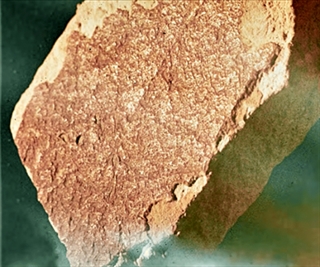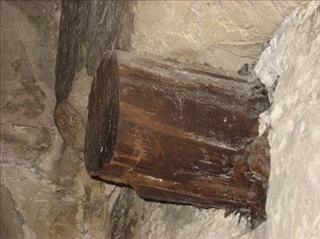How we're the pyramids built, the questions continues. This has been a controversial subject and many hypotheses exist. Mostly, the greatest concern is about the different theories on how the way the stones were moved into place. Some say huge the stones were carved from quarries with copper chisels, moved and dragged into place. Others say the builders had simple machines, such as the ramp and the lever, to aid construction processes, or even were employed by some kind of slave labor.
(1)
So how were they built? Joseph Davidovits, a french materials scientist, claims that the stones of the pyramids were made by simple chemistry, a very early form of concrete, which look exactly like natural rocks too. Made of a mixture of limestone, clay, lime, and water and finally cast into molds.
(2)(3)
According to Davidovits, soft limestone with a high kaolinite content was quarried
(4) and then the limestone was dissolved until it became watery. Lime and natron (also used by the Egyptians in mummification) were mixed in. The pools were then left to evaporate, leaving behind a moist, clay-like mixture. This wet "concrete" would be carried to the construction site where it would be packed into reusable molds, and in a few days, would undergo a chemical reaction similar to concrete.
 The Lauer sample
The Lauer sampleOptical and scanning electron microscopical examinations show samples of the limestone pyramid blocks mineral compounds and air bubbles that do not occur in natural limestone.
(5) A study also found the presence of carbon clusters
(6) in the Great Pyramid that were identified with a nuclear microprobe and would seem to indicate that the clusters are of organic origin. Their location in the pyramid samples coincide with the position of other clusters containing sodium.
"...all these observations fit with the model of construction created by Davidovits, who states that the blocks of the Khufu pyramid were cast in situ using granular limestone aggregates, natron, lime (probably produced by the combustion of wood in domestic fires) and water to produce an alkali alumino–silicate based binder."(7)(8)
 support log inside the pyramid of Meidum
support log inside the pyramid of MeidumWood also plays apart a great part in Davidovits theory. In the pyramid of Meidum. Just below the original ground level of the pyramid, there is a vertical shaft 10 feet high that leads to a burial chamber. Inside you will find one of the supports has a log inside of it. Davidovits says this is evidence of a concrete mold.
(9) And That the builders left it during construction. Thankfully it lives on as a reminder to us.
There are holes and gaps in the Davidovits theory, like the granite stones, weighing well over 10 tons, above the King's Chamber, which he agrees were carved. Geologists have carefully scrutinized Davidovits's theory and argue the limestone is natural and was quarried.
(4) If the builders of the pyramid we're able to create such a wonder, mathematically, then isn't possible they also had the knowledge to possess simple chemistry. Self delusion is the price we pay for the ignorance of that person. Whether they are a tenured professor, credited archeologist, or just a amateur student. These are the same people who probably think the Great Pyramid served as a tomb. This still has yet to be proven because no pharaohs, sarcophagi, or mummies have been recovered from the Great Pyramid.
(10)